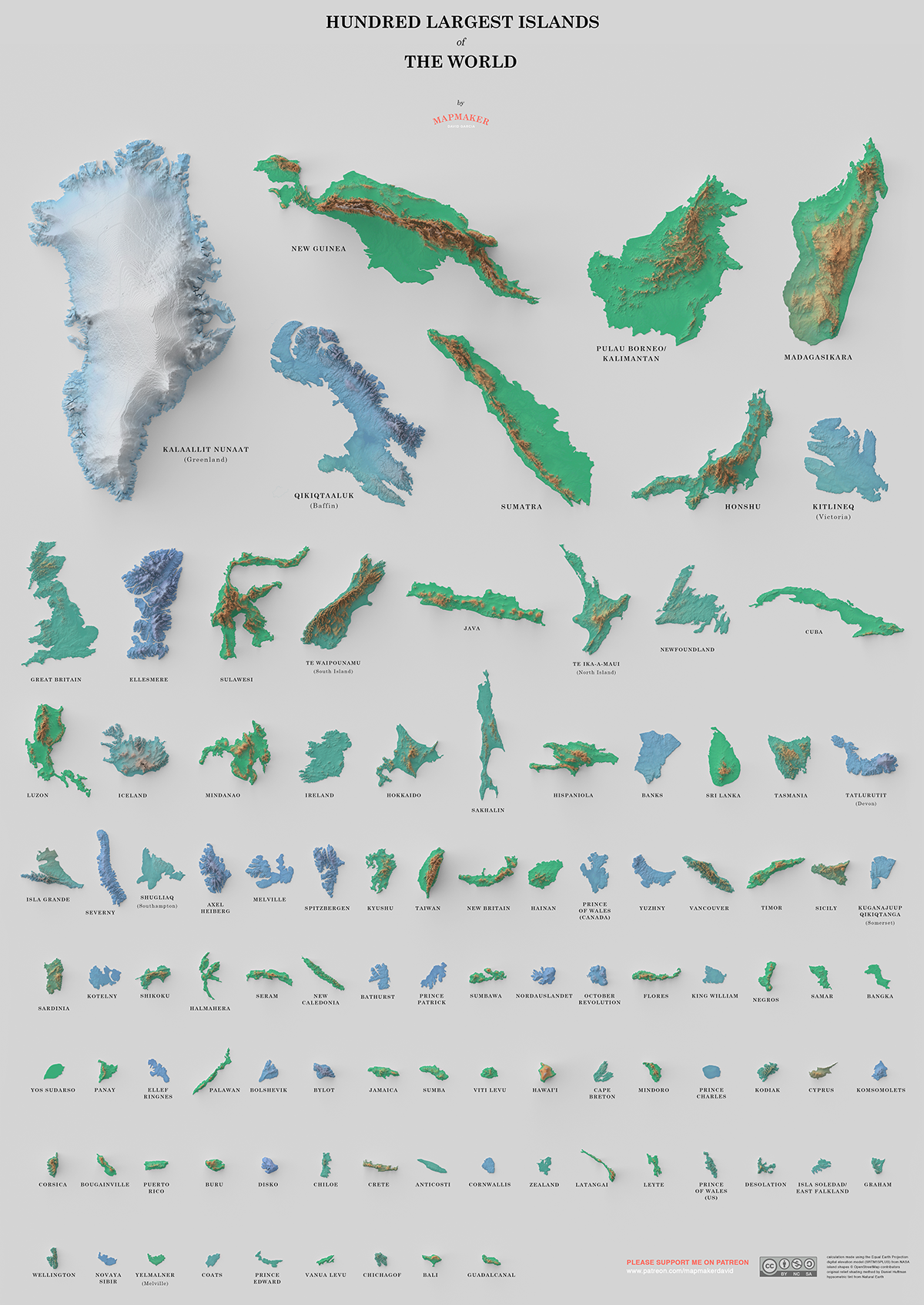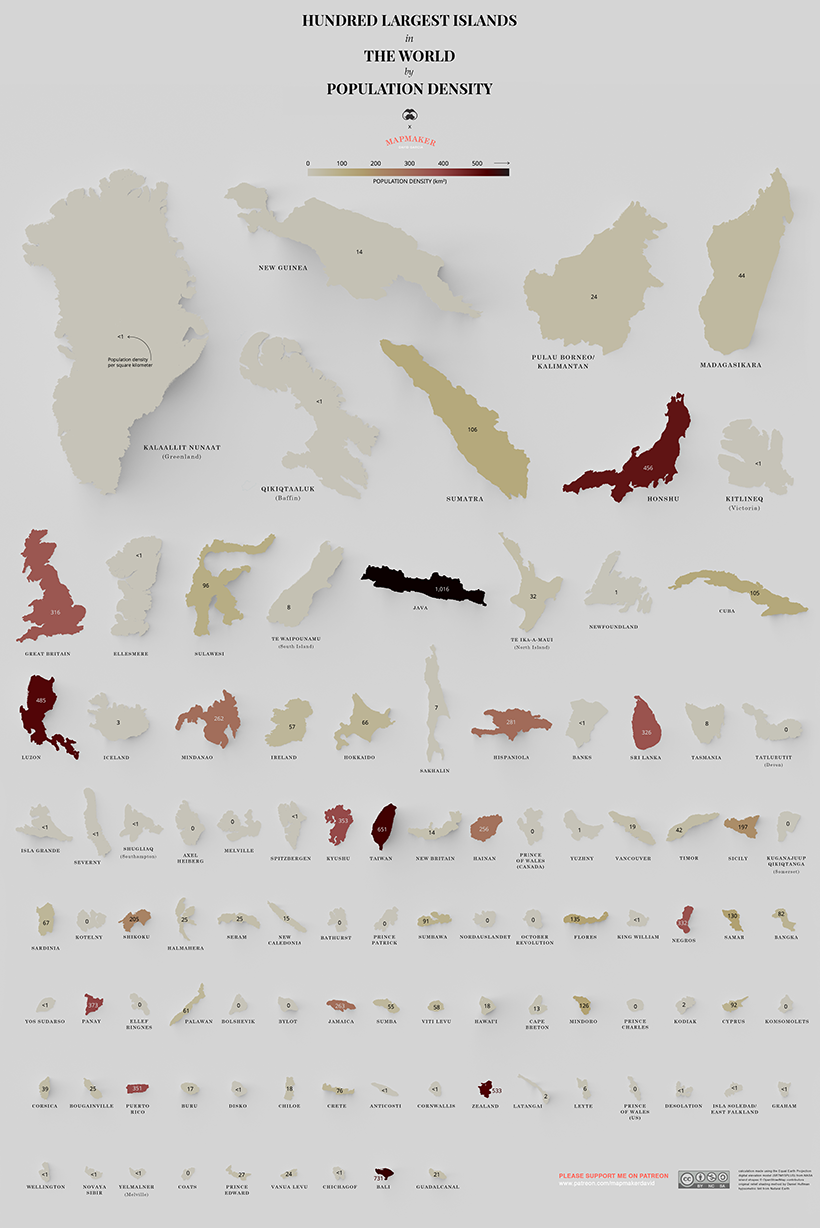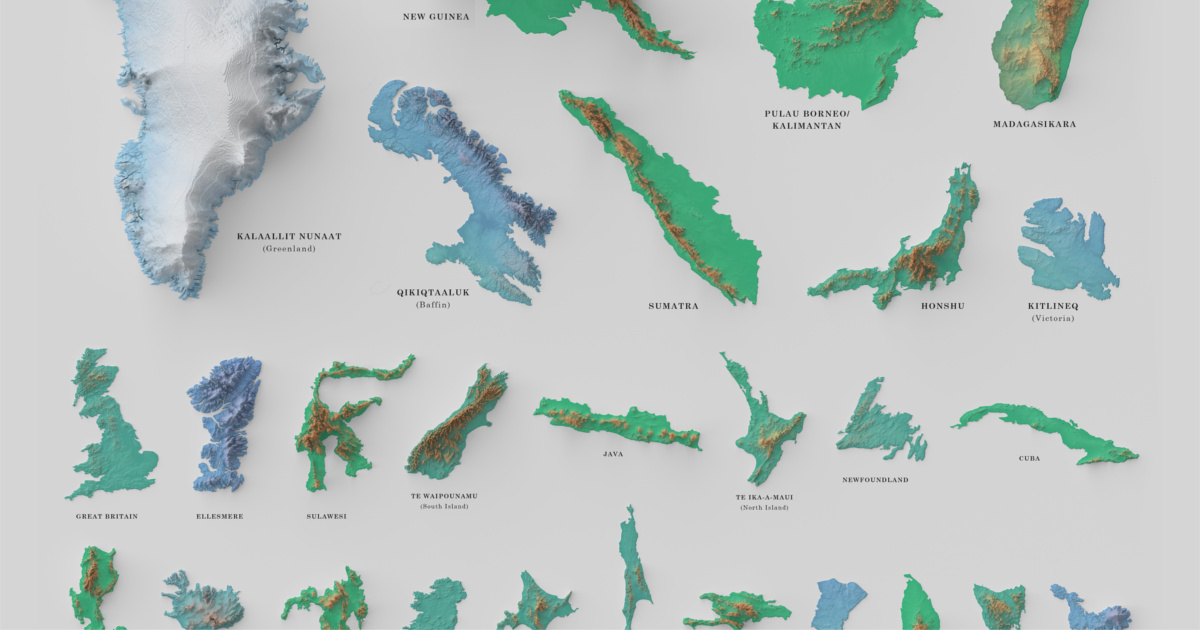Misc
Visualizing the World’s 100 Biggest Islands
View the full-size version of the infographic.
Visualizing 100 of the World’s Biggest Islands
View the full-size version of the infographic by clicking here.
When you think of an island, the first thing that might come to mind is a small, sunny beach surrounded by warm waters. But did you know that 11% of the world’s population actually calls islands their home?
Today’s data visualization is designed by mapmaker David Garcia, and it ranks the 100 largest islands found around the world by size.
Islands in the Stream
The 100 biggest islands range from the likes of expansive Greenland to independent Guadalcanal, the largest of the Solomon Islands. But look a little closer, and you’ll see just how much the top contender outshines the rest. Greenland is almost three times the size of the second-biggest island of New Guinea, and you could fit over 408 Guadalcanal islands within it.
In the visualization, the islands are also tinted, depending on the climate they come from. Blue islands are from the polar regions, turquoise islands lie in the temperate zones, and green islands represent the lush tropics. Which of these regions hosts the most islands?
| Island | Countries | Region |
|---|---|---|
| Kalaallit Nunaat (Greenland) | Denmark | Europe |
| New Guinea | Papua New Guinea, Indonesia | Oceania |
| Pulau Borneo (Kalimantan) | Indonesia, Malaysia, Brunei | Asia |
| Madagasikara | Madagascar | Africa |
| Qikiqtaaluk (Baffin Island, Nunavut) | Canada | North America |
| Sumatra | Indonesia | Asia |
| Honshu | Japan | Asia |
| Kitlineq (Victoria Island) | Canada | North America |
| Great Britain | United Kingdom | Europe |
| Ellesmere (Nunavut) | Canada | North America |
| Sulawesi | Indonesia | Asia |
| Te Waipounamu (South Island) | New Zealand | Oceania |
| Java | Indonesia | Asia |
| Te Ika-a-maui (North Island) | New Zealand | Oceania |
| Newfoundland | Canada | North America |
| Cuba | Cuba | North America |
| Luzon | Philippines | Asia |
| Iceland | Iceland | Europe |
| Mindanao | Philippines | Asia |
| Ireland | Ireland, United Kingdom | Europe |
| Hokkaido | Japan | Asia |
| Sakhalin | Russia | Eurasia |
| Hispaniola | Dominican Republic, Haiti | North America |
| Banks Island | Canada | North America |
| Sri Lanka | Sri Lanka | Asia |
| Tasmania | Australia | Oceania |
| Tatlurutit (Devon Island, Nunavut) | Canada | North America |
| Isla Grande de Tierra del Fuego | Panama | South America |
| Severny | Russia | Eurasia |
| Shugliaq (Southampton) | Canada | North America |
| Axel Heiberg (Nunavut) | Canada | North America |
| Melville | Canada | North America |
| Spitsbergen (Svalbard) | Norway | Europe |
| Kyushu | Japan | Asia |
| Taiwan | Taiwan | Asia |
| New Britain | Papua New Guinea | Oceania |
| Hainan | China | Asia |
| Prince of Wales (Nunavut) | Canada | North America |
| Yuzhny | Russia | Eurasia |
| Vancouver | Canada | North America |
| Timor | Timor Leste | Asia |
| Sicily | Italy | Europe |
| Kuganajuup Qikiqtanga (Somerset, Nunavut) | Canada | North America |
| Sardinia | Italy | Europe |
| Kotelny | Russia | Eurasia |
| Shikoku | Japan | Asia |
| Halmahera | Indonesia | Asia |
| Seram | Indonesia | Asia |
| New Caledonia | France | Europe |
| Bathurst (Nunavut) | Canada | North America |
| Prince Patrick | Canada | North America |
| Sumbawa | Indonesia | Asia |
| Nordaustlandet | Norway | Europe |
| October Revolution | Russia | Eurasia |
| Flores | Indonesia | Asia |
| King William (Nunavut) | Canada | North America |
| Negros | Philippines | Asia |
| Samar | Philippines | Asia |
| Bangka | Indonesia | Asia |
| Yos Sudarso | Papua New Guinea | Oceania |
| Panay | Philippines | Asia |
| Ellef Ringnes (Nunavut) | Canada | North America |
| Palawan | Philippines | Asia |
| Bolshevik | Russia | Eurasia |
| Bylot (Nunavut) | Canada | North America |
| Jamaica | Caribbean | North America |
| Sumba | Indonesia | Asia |
| Viti Levu | Fiji | Oceania |
| Hawai'I (Big Island) | United States | North America |
| Cape Breton | Canada | North America |
| Mindoro | Philippines | Asia |
| Prince Charles | Canada | North America |
| Kodiak (Alaska) | United States | North America |
| Cyprus | Cyprus, United Kingdom | Europe |
| Komsomolets | Russia | Eurasia |
| Corsica | France | Europe |
| Bougainville | Papua New Guinea | Oceania |
| Puerto Rico | United States | North America |
| Buru | Indonesia | Asia |
| Disko | Greenland | Europe |
| Chiloé | Chile | South America |
| Crete | Greece | Europe |
| Anticosti | Canada | North America |
| Cornwallis (Nunavut) | Canada | North America |
| Zealand | Denmark | Europe |
| Latangai (New Ireland) | Papua New Guinea | Oceania |
| Leyte | Philippines | Asia |
| Prince of Wales (Alaska) | United States | North America |
| Desolation (Kerguelen) | Antarctic Lands, France | Antarctic |
| Isla Soledad/ East Falkland | Argentina | South America |
| Graham | Canada | North America |
| Wellington | Chile | South America |
| Novaya Sibir (New Siberian) | Russia | Eurasia |
| Yelmalner/ Melville | Australia | Oceania |
| Coats (Nunavut) | Canada | North America |
| Prince Edward | Canada | North America |
| Vanua Levu | Fiji | Oceania |
| Chichagof (Alaska) | United States | North America |
| Bali | Indonesia | Asia |
| Guadalcanal | Solomon Islands | Oceania |
It’s the Island Life for Many
North America dominates with 32 islands out of the top 100, but there’s a catch — twelve of them are uninhabitable, thanks to the frigid Arctic temperatures.
Throw the number of people into the mix and the regional overview gets even more interesting. Compared to the rest of the world, Asian islands are teeming with life.
- 28 Asian islands
Total population: 510.4 million - 14 European islands
Total population: 83.8 million - 32 North American islands
Total population: 40.7 million - 12 Oceania islands
Total population: 18.3 million
Taking things a step further, we’ve remixed the visualization based on population density.
Click below to view the full-size version.
The most populated island in the world, Java is filled to the brim with 141 million people — that’s over a thousand people per square kilometer. This is in part thanks to the capital city Jakarta being located on the island, but experts warn those days may be short-lived. By 2050, scientific models predict that 95% of the city may be underwater, and that Indonesia must scramble to find a new capital.
To finish, here is the 20 most dense islands on the list, in terms of population density.
| Rank by Density | Island | Countries | Population | Area (km²) | People per km² |
|---|---|---|---|---|---|
| #1 | Java | Indonesia | 141,000,000 | 138,793 | 1,015.9 |
| #2 | Bali | Indonesia | 4,225,000 | 5,780 | 731.0 |
| #3 | Taiwan | Taiwan | 23,571,000 | 36,193 | 651.3 |
| #4 | Zealand | Denmark | 3,749,200 | 7,031 | 533.2 |
| #5 | Luzon | Philippines | 53,336,134 | 109,965 | 485.0 |
| #6 | Honshu | Japan | 104,000,000 | 227,960 | 456.2 |
| #7 | Panay | Philippines | 4,477,247 | 12,011 | 372.8 |
| #8 | Kyushu | Japan | 12,970,479 | 36,753 | 352.9 |
| #9 | Puerto Rico | United States | 3,195,000 | 9,104 | 350.9 |
| #10 | Negros | Philippines | 4,414,131 | 13,310 | 331.6 |
| #11 | Sri Lanka | Sri Lanka | 21,440,000 | 65,610 | 326.8 |
| #12 | Great Britain | United Kingdom | 66,040,000 | 209,331 | 315.5 |
| #13 | Hispaniola | Dominican Republic, Haiti | 21,396,000 | 76,192 | 280.8 |
| #14 | Jamaica | Caribbean | 2,890,000 | 10,992 | 262.9 |
| #15 | Mindanao | Philippines | 25,537,691 | 97,530 | 261.8 |
| #16 | Hainan | China | 8,670,000 | 33,920 | 255.6 |
| #17 | Shikoku | Japan | 3,845,534 | 18800 | 204.5 |
| #18 | Sicily | Italy | 5,057,000 | 25,711 | 196.7 |
| #19 | Flores | Indonesia | 1,831,000 | 13,540 | 135.2 |
| #20 | Samar | Philippines | 1,751,267 | 13,429 | 130.4 |
The Australia-Island Debate
Upon first publishing this over two years ago, the most common feedback we heard came from our friends Down Under.
In school, many Australians learned that their beloved country was an “island continent”, and naturally felt it should be included on the list of the world’s 100 biggest islands.
As with anything, there are different schools of thought on this. Upon digging deeper, we believed that Encyclopedia Britannica had a explanatory take on the issue:
“Most geographers consider islands and continents to be separate things. An island is a mass of land that is both ‘entirely surrounded by water’ and also ‘smaller than a continent.’ By that definition, Australia can’t be an island because it’s already a continent.”
–Encyclopedia Britannica
There are, of course, opposing arguments that could be had—but at least this gives some perspective on why Australia was likely excluded from this particular list.
This post was first published in 2019. We have since updated it, adding in new content for 2021.
Maps
The Largest Earthquakes in the New York Area (1970-2024)
The earthquake that shook buildings across New York in April 2024 was the third-largest quake in the Northeast U.S. over the past 50 years.

The Largest Earthquakes in the New York Area
This was originally posted on our Voronoi app. Download the app for free on Apple or Android and discover incredible data-driven charts from a variety of trusted sources.
The 4.8 magnitude earthquake that shook buildings across New York on Friday, April 5th, 2024 was the third-largest quake in the U.S. Northeast area over the past 50 years.
In this map, we illustrate earthquakes with a magnitude of 4.0 or greater recorded in the Northeastern U.S. since 1970, according to the United States Geological Survey (USGS).
Shallow Quakes and Older Buildings
The earthquake that struck the U.S. Northeast in April 2024 was felt by millions of people from Washington, D.C., to north of Boston. It even caused a full ground stop at Newark Airport.
The quake, occurring just 5 km beneath the Earth’s surface, was considered shallow, which is what contributed to more intense shaking at the surface.
According to the USGS, rocks in the eastern U.S. are significantly older, denser, and harder than those on the western side, compressed by time. This makes them more efficient conduits for seismic energy. Additionally, buildings in the Northeast tend to be older and may not adhere to the latest earthquake codes.
Despite disrupting work and school life, the earthquake was considered minor, according to the Michigan Technological University magnitude scale:
| Magnitude | Earthquake Effects | Estimated Number Each Year |
|---|---|---|
| 2.5 or less | Usually not felt, but can be recorded by seismograph. | Millions |
| 2.5 to 5.4 | Often felt, but only causes minor damage. | 500,000 |
| 5.5 to 6.0 | Slight damage to buildings and other structures. | 350 |
| 6.1 to 6.9 | May cause a lot of damage in very populated areas. | 100 |
| 7.0 to 7.9 | Major earthquake. Serious damage. | 10-15 |
| 8.0 or greater | Great earthquake. Can totally destroy communities near the epicenter. | One every year or two |
The largest earthquake felt in the area over the past 50 years was a 5.3 magnitude quake that occurred in Au Sable Forks, New York, in 2002. It damaged houses and cracked roads in a remote corner of the Adirondack Mountains, but caused no injuries.
| Date | Magnitude | Location | State |
|---|---|---|---|
| April 20, 2002 | 5.3 | Au Sable Forks | New York |
| October 7, 1983 | 5.1 | Newcomb | New York |
| April 5, 2024 | 4.8 | Whitehouse Station | New Jersey |
| October 16, 2012 | 4.7 | Hollis Center | Maine |
| January 16, 1994 | 4.6 | Sinking Spring | Pennsylvania |
| January 19, 1982 | 4.5 | Sanbornton | New Hampshire |
| September 25, 1998 | 4.5 | Adamsville | Pennsylvania |
| June 9, 1975 | 4.2 | Altona | New York |
| May 29, 1983 | 4.2 | Peru | Maine |
| April 23, 1984 | 4.2 | Conestoga | Pennsylvania |
| January 16, 1994 | 4.2 | Sinking Spring | Pennsylvania |
| November 3, 1975 | 4 | Long Lake | New York |
| June 17, 1991 | 4 | Worcester | New York |
The largest earthquake in U.S. history, however, was the 1964 Good Friday quake in Alaska, measuring 9.2 magnitude and killing 131 people.
-

 Technology2 weeks ago
Technology2 weeks agoRanked: The Most Popular Smartphone Brands in the U.S.
-

 Misc1 week ago
Misc1 week agoAlmost Every EV Stock is Down After Q1 2024
-

 Money1 week ago
Money1 week agoWhere Does One U.S. Tax Dollar Go?
-

 Green2 weeks ago
Green2 weeks agoRanked: Top Countries by Total Forest Loss Since 2001
-

 Markets2 weeks ago
Markets2 weeks agoVisualizing America’s Shortage of Affordable Homes
-

 Maps2 weeks ago
Maps2 weeks agoMapped: Average Wages Across Europe
-

 Mining2 weeks ago
Mining2 weeks agoCharted: The Value Gap Between the Gold Price and Gold Miners
-

 Demographics2 weeks ago
Demographics2 weeks agoVisualizing the Size of the Global Senior Population















